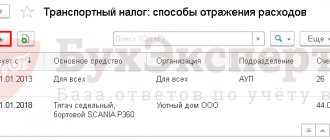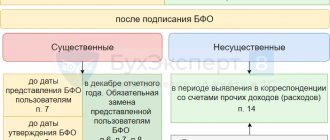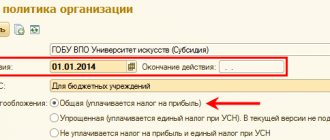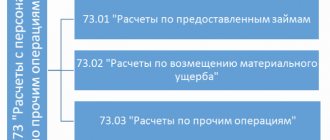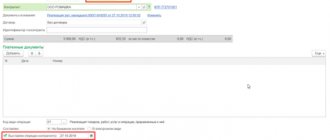A car owned by an organization is depreciable movable property.
From the month following the month the vehicle was registered, the company must calculate depreciation. To do this, you need to correctly determine the useful life of the vehicle and choose depreciation methods, reflecting your choice in accounting and tax policies.
Methods of calculation in an organization in accounting
Depreciation in accounting begins the next month - from the 1st day. It does not matter whether the car is registered with the traffic police or not, or whether a change of ownership has been registered.
In accounting, clause 18 of PBU 6/01 provides for 4 methods of depreciation:
- Linear;
- Declining balance – accelerated;
- By the sum of the numbers of years of use;
- Proportional to the volume of products, services, works.
An organization can choose any of the above methods, there are no restrictions.
But it is important to reflect the choice in accounting policies. The depreciation method is chosen to be the same for all similar vehicles.
Methods for tax accounting
It is important to know depreciation in order to correctly calculate income taxes. Depreciation deductions reduce the tax base by writing off as expenses.
The Tax Code of the Russian Federation quite strictly defines the procedure for writing off the cost of fixed assets through deductions.
To determine the useful life, a Classification has been developed, according to which depreciation group 3, 4 or 5 can be selected for a car. How to choose a shock absorption group for a car?
In tax accounting, in accordance with clause 1 of Article 259 of the Tax Code of the Russian Federation, only two methods of calculating depreciation are possible:
- linear;
- nonlinear.
An organization can choose any one, reflecting it in its tax accounting policy.
It is important that the prescribed calculation method will apply to absolutely all fixed assets.
It will be possible to change it only from the beginning of next year, again for all OS objects at once. You can change the nonlinear method to a linear one no more often than every 5 years.
An exception is the property listed in clause 3 of Article 259 of the Tax Code of the Russian Federation; for it it is mandatory to use the linear write-off method, regardless of the general method chosen (buildings, structures, transfer devices).
Foreign car for an accountant
On city streets, foreign-made cars occupy a dominant position. When choosing a car, any manager of an organization will certainly give preference to a “foreign car”.
In order to limit the organization's expenses, tax accounting provides for a special coefficient of 0.5 to the basic depreciation rate for passenger cars and passenger minibuses with an initial cost of, respectively, more than 300 thousand rubles and 400 thousand rubles (clause 9 of Article 259 of the Tax Code of the Russian Federation). In establishing this cost limit, the legislator was probably focusing primarily on the cost of domestic passenger cars.
This is not the first “tax” restriction on cars and minibuses. Let us recall that before the introduction of Chapter 21 “Value Added Tax” of the Tax Code of the Russian Federation in accordance with clause 2 of Art. 7 of the Law of 06.12.1991 N 1992-1 “On Value Added Tax” (repealed), taxpayers did not have the right to reduce the amount of VAT payable to the budget by taxes paid on the purchase of official cars and minibuses.
But in connection with the application of a special coefficient for cars and minibuses, the question arises: over what period should depreciation be calculated for these types of depreciable property?
In accordance with paragraph 1 of Art. 258 of the Tax Code of the Russian Federation, when purchasing a passenger car (as well as another item of depreciable property) and putting it into operation, the taxpayer independently determines its useful life on the basis of the Classification of fixed assets included in depreciation groups, approved by Decree of the Government of the Russian Federation dated 01.01.02 N 1.
The same norm of the Tax Code of the Russian Federation provides for possible cases of increasing the useful life of an object of fixed assets after the date of its commissioning: after reconstruction, modernization or technical re-equipment of such an object. However, even in these cases, an increase in the useful life of fixed assets can be carried out only within the time limits established for the depreciation group in which such fixed assets were previously included. The Tax Code of the Russian Federation does not establish the possibility of adjusting the useful life when applying special or other coefficients established by Art. 259 of the Tax Code of the Russian Federation. Moreover, the application of a special coefficient cannot in any way extend the useful life of a fixed asset, which recognizes the period during which an object of fixed assets serves to fulfill the goals of the taxpayer’s activities.
As a rule, organizations do not use such cars for a long time and prefer to sell them in a timely manner
Thus, when purchasing a passenger car (or minibus) on the date of putting it into operation, the taxpayer determines its useful life for tax accounting purposes. In accordance with the Classification of fixed assets, passenger cars belong to the third depreciation group, i.e. The useful life can be determined in the range from 3 to 5 years. The exception is large-class passenger cars (with an engine displacement of over 3.5 liters) and high-class cars, which belong to the fifth group (property with a useful life of over 7 years to 10 years inclusive).
The useful life established by the taxpayer is the basis for determining the depreciation rate. At the same time, when calculating depreciation on cars and minibuses (if their original cost, respectively, is more than 300 and 400 thousand rubles), for profit tax purposes, the taxpayer is obliged to apply a special coefficient of 0.5 to the basic depreciation rate. The use of this coefficient in contrast to others established by Art. 259 of the Tax Code of the Russian Federation is an obligation, not a right of the taxpayer. As a result of applying a special coefficient, upon expiration of the useful life, only half of the original cost of the car will be written off as expenses for income tax purposes.
Taking into account that the useful life should be the period during which depreciation is recognized as an expense of the organization, it turns out that the organization formally does not have the right to recognize the second half of the original cost as an expense in tax accounting. At the same time, according to paragraph 2 of Art. 259 of the Tax Code of the Russian Federation, the accrual of depreciation on an object of depreciable property ceases after the complete write-off of the cost of such property or disposal of the object. This norm suggests the conclusion that even after the expiration of its useful life, the taxpayer has the right to continue to charge depreciation on a passenger car costing over 300 thousand rubles. or a minibus worth 400 thousand rubles. This is exactly the conclusion that the Russian Ministry of Finance and tax authorities make when giving private explanations (for example, letter from the Federal Tax Service for Moscow dated February 17, 2005 N 20-12/10061).
At the same time, according to the author, the use of a special coefficient does not lead to an increase in the useful life of a fixed asset, but indicates an increase in the period of expense recognition. This is precisely the technique that the legislator uses when recognizing certain types of expenses, in particular, when writing off the residual value of fixed assets, the actual useful life of which as of January 1, 2002 exceeded the maximum useful life of the corresponding depreciation group. Otherwise, it should be recognized that when a special coefficient is applied, regardless of the taxpayer, the useful life of a passenger car or passenger minibus is revised - it is doubled, which automatically transfers the specified object to another depreciation group, and this is not the norm of the Tax Code. allowed. At the same time, it should be noted that the FAS Volga District, in its resolution dated October 4, 2006 in case No. A55-1588/06, indicated that the use of a special coefficient leads to an increase in useful life.
But, as a rule, organizations do not use such cars for a long time and prefer to sell them in a timely manner. Often the result of such a transaction is a loss. According to paragraph 3 of Art. 268 of the Tax Code of the Russian Federation, a loss from the sale of depreciable property is included in the taxpayer’s other expenses in equal shares over a period defined as the difference between the useful life of this property and the actual period of its operation until the moment of sale. It would seem that this rule is a solution to the taxpayer’s problem. Thus, by selling a car before the end of its useful life, the taxpayer has the right to write off the residual value of the car over the remaining useful life. If the sale of a car occurs at the end of its useful life, then, in the author’s opinion, the organization has the right to recognize the loss at a time.
But the Russian Ministry of Finance does not agree with this approach. In particular, in a letter dated January 19, 2007 N 03-03-06/1/14, the Ministry of Finance of Russia explained that the loss from the sale of depreciable property should be included in other expenses during the period defined as the difference between adjusted by a special coefficient of 0, 5 the useful life of this property and the actual period of its operation until the moment of sale. Thus, the Russian Ministry of Finance once again emphasized that by useful life it means precisely the period during which depreciation is calculated.
It should be recalled that from January 1, 2007, tax authorities are obliged to follow the explanations of the Russian Ministry of Finance on the application of tax legislation (subclause 5, clause 1, article 32 of the Tax Code of the Russian Federation).
www.palata-nk.ru
conclusions
A car is recognized as a fixed asset if it is not intended for resale. Its useful life is determined and depreciation is charged.
In accounting, it is convenient to choose either a linear calculation method or proportional to the volume of work - by kilometer (based on mileage).
In tax accounting, you can choose a linear or nonlinear method.
For vehicles leasing, you can use an accelerated method of deductions using an accelerating coefficient.
Correct calculation of car depreciation
Depreciation of a car, not expressed in scientific terms, is an accounting of its wear and tear expressed in monetary terms. Any car requires costs: for repairs, for replacing technical fluids, for replacing tires, and, of course, the cost of refueling it.
When calculating vehicle depreciation, fuel costs are not taken into account.
Why do you need to calculate car depreciation?
- Firstly, it is necessary for entrepreneurs and legal entities to submit documentation to the tax authorities. In this way, the company’s expenses are described in detail so that tax authorities do not have questions regarding the expenditure of funds.
- Secondly, depreciation is taken into account by insurance companies for a more accurate assessment of the real value of the car when its owner wants to enter into an insurance contract. Banks or car pawnshops also take depreciation into account when buying and selling used cars.
- Thirdly, a common situation is when a company employee uses his personal transport to perform his duties. In this case, the employer is obliged to take into account not only the cost of refueling, but also depreciation, that is, wear and tear of the car. Typically, companies pay 1.5-3 rubles for each kilometer driven.
Every owner of a private car should also take into account wear and tear so that the cost of replacing filters or oil does not come as a surprise.
How is depreciation calculated?
Calculating car depreciation is not as difficult a task as it might seem. For example, in many automobile magazines we can see such information that every kilometer that we drive in such and such a car model costs us 3 or 7 rubles, and this is in addition to the cost of refueling.
Where do these numbers come from?
If you do not have special accounting knowledge, then you just need to consistently take into account all the expenses for your car throughout the year: consumables, brake fluid, oil, replacement of parts. As a result, you will receive a certain amount, for example 20 thousand. Divide this amount by the number of kilometers traveled per year and find out how much one kilometer costs you.
You can go another way:
- take into account all the costs of undergoing scheduled inspections and technical inspections;
- look at the instructions after how many kilometers you will need to replace all filters, process fluids, brake pads, change the oil in the engine, automatic transmission, power steering, etc., take into account the cost of all this work;
- make complex mathematical calculations - divide the resulting amount by the mileage that your car will cover by that time, and get the approximate cost of one kilometer.
It is worth noting that this method will not be very accurate, if only because every year your cash costs for a car will only increase . But such a calculation will tell you how much money you need to have so that the next breakdown does not hit your budget too hard.
To get more accurate data, you need to not only take into account your costs for certain spare parts and consumables, but also:
- age of the vehicle;
- its total mileage;
- the conditions under which it is operated;
- manufacturer (it is no secret that German cars do not need as frequent repairs as Chinese ones);
- the environmental situation in the area where you live;
- climate humidity;
- region type - metropolis, city, town, village.
In the accounting literature you can find various coefficients that will help you more accurately calculate the depreciation of a vehicle. For example, all cars are divided into categories depending on age:
- up to five years;
- from five to seven;
- from seven to ten years.
Accordingly, the older the vehicle, the more money you need to spend on it.
Formula for calculating vehicle depreciation
Vehicle depreciation is calculated as a percentage. To do this you need to know:
- wear rate;
- actual mileage;
- wear and tear due to old age;
- actual service life;
- adjustment factors - climatic and environmental conditions in the area where the car is used;
- region type.
All these indicators and ratios can be found in the accounting literature. If you do not want to delve into all these regulations and resolutions of the Ministry of Finance, then you can find an online calculator on the Internet to calculate depreciation, and simply insert the actual data into the specified fields.
Here's an example:
- a domestic car, which we bought for 400 thousand two years ago;
- mileage over 2 years amounted to 40 thousand;
- operated in a city with a population of up to a million people.
We receive data:
- estimated wear - 18.4%;
- natural wear and tear - 400 thousand multiplied by 18.4% = 73,600 rubles;
- residual value - 326,400 rubles;
- market value taking into account obsolescence (20%) - 261,120 rubles.
We can also find out how much it costs us to run one kilometer - divide 73.6 thousand by 40 thousand and get 1.84 rubles. But this does not take into account obsolescence. If we also take into account obsolescence, we get 3 rubles 47 kopecks.
It is worth noting that obsolescence significantly affects the reduction in cost of vehicles. However, it is rarely used, or the obsolescence coefficient is set at the level of one, that is, it does not affect the cost of the vehicle in any way.
Here you can argue for a long time with theorists and prove that some Audi A3 of 2008, compared to the new Lada Kalina of 2013, is not only not morally outdated, but, on the contrary, is several decades ahead of it.
Another important point is that all the above coefficients are averaged and do not take into account many other objective factors, the main one of which is the driver’s skill. Agree that large transport enterprises practice a completely different approach than a small company delivering buns around the city. However, thanks to such calculations, you will know approximately how much it will cost you to operate the car. This data can also be used when purchasing used cars.
( 9 ratings, average: 3.56 out of 5)


